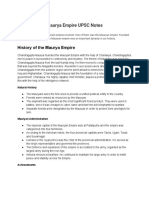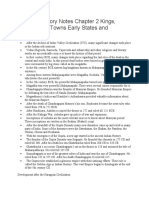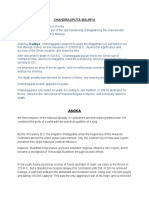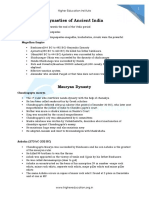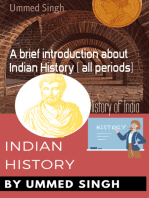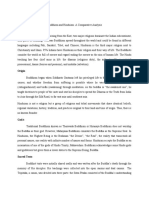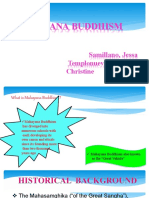Mauryan Empire
Sources of Mauryan History
The period of Maurya Empire writes a new history in the history of India. Much is known about the old history of the Maurya Empire, although a large part is still unknown and historians are engaged in its decipherment. The sources of history of Maurya period are as follows-
Megasthenes
Megasthenes was the ambassador of the Greek ruler Seleucus. Megasthenes was i
n the court of Chandra Gupta and lived in India for fourteen years. In his book 'Indica' he has described various aspects of Indian life including the administration of the state, local administration, life of the king. It is one of the most important sources to know the details about the Maurya dynasty.
Kautilya's economics
Kautilya's Arthashastra is also a very important source of knowledge of the Maurya dynasty. Chanakya or Kautilya was the minister of Chandra Gupta. He has thrown light on the contemporary social, political and economic conditions of the country at that time. He also gave information about the duties of the king, his foreign policy and organization of spies.
Inscription
Ashoka's inscriptions are the most important sources of the Maurya period. They are important for imparting knowledge about the extent of his empire, his religious policy, administration and his character.
other sources
The 'Mahavansh', 'Dipamras', 'Dibyavadan' Buddhist texts provide a lot of information regarding the Maurya period. Vishakhadatta's Mudrarakshasa is an important book. Puranas, Tibetan and Nepali books are also important. The Junagadh inscription, which was written by Rudradaman, is also an important text.
Rise of the Mauryan Empire
The Mauryan Empire started from Magadha was founded in 321 BC by Chandragupta Maurya. Mudrarakshasha written by Vishakadatta beautifully summarizes the rise of Chandragupta Maurya with the help of Chanakya. Chandragupta Maurya patronized Jainism. Pataliputra, modern-day Patna was the capital city of Mauryan Empire.
Expansion of Mauryan Empire
Mauryan Empire was one of the world's largest empires of that time and expanded to an area of 5,000,000 km2. Leaving the parts of NE India, Kerala and Tamil Nadu, the Mauryans ruled over

mperial Organization
1.
Accounts of Megasthenes in his book
Indika
and the
Arthashastra
(written by Kautilya) describe the elaborate arrangements made in the Mauryan administration, society and economy. 2.
The empire was divided into provinces which were under Princes. Along with this, a dozen departments, the armed forces containing six wings were also maintained. Chandragupta established a well-organized administrative system and gave it a sound financial base.
List of Rulers of Mauryan Dynasty
Sr. N0
Emperor Name
Duration
1. Emperor Chandragupta Maurya 321-298BC 2. Emperor Bindusara Maurya 298-273BC 3. Emperor Ashoka the Great 273-232BC 4. Kunal Maurya 232-
228BC 5. Dasharatha Maurya 228-224BC 6. Samprati Maurya 224-215BC 7. Shalisuk Maurya 215-202BC 8. Devvarman Maurya 202-195BC 9. Shatadhanvan Maurya 195-187BC 10. Brihadratha Maurya 187-185BC
Chandragupta Maurya (321 - 298 BC)
Chandragupta Maurya was the great emperor of India. He founded the Maurya Empire. The date of accession of Chandragupta Maurya is generally 321 BC. is determined. He ruled for about 24 years. Megasthenes served as a Greek ambassador in the assembly of Chandragupta for four years. In Greek and Latin writings, Chandragupta is referred to as Sandrocotes and Endocottus respectively. According to Plutarch, Sandrocottus conquered the whole of India by a huge corps of 6,00,000 soldiers and subdued him. According to Justin's opinion, India was under the control of Chandragupta. Chandragupta had also conquered Saurashtra. The Junagadh inscription of Mahakshatrapa Rudradaman proves that Vaishya Pushyagupta was the governor here. The last battle of Chandragupta took place in 305 BC. As happened with Seleucus, Alexander's former general and his contemporary, the Greek emperor of Syria, Seleucus had to bow down to the power of Chandragupta. According to the inscriptions found from Shravanabelagola, Chandragupta went to Shravanabelagola with Bhadrabahu in his last days. There he renounced his body by fasting. Chandra-gupta became the last crown-bearing sage, after him there was no other crown-bearer (ruler) Digambara-muni. Therefore, Chandra-gupta has an important place in Jainism.
Bindusara (298-273 BC)
Bindusara is known as 'father's son and son's father' because he was the son of the famous and mighty ruler Chandragupta Maurya and the father of the great king Ashoka. Bindusara has also been called Amitraghat, Simhasen, Madrasa and Varisara. And he was a follower of the Ajivak sect. Chandragupta Maurya and Durdhara's son Bindusara got the rule of a large state in the estate. The people of Taxila revolted twice under Bindusara's rule. The first revolt was due to the misadministration of Bindusara's eldest son Sushim. The reason for the second rebellion is unknown but it was suppressed by Ashoka, the son of Bindusara. Friendship with the Syrian emperor continued even during his reign. Megasthe
nes' successor, Dimachus, lived in Bindusara's court as an emissary of the Syrian emperor. According to Pliny, the Egyptian emperor Ptolemy Philadelphus (285-247 BC) also sent his ambassador to the court of the Indian king. Athenaeus mentions the correspondence of the Syrian emperor Antiochus I Soter and Bindusara. King Amitraghat had requested Antiochus to buy wine and sophists from his country and send him. It was said in the reply that we will be able to send liquor to you, but according to the Greek law, sophists are not sold.
Ashoka (273
–
232 BC)
Ashoka ascended the throne in 273BC and ruled up to 232 BC. He was known as ‘Devanam Priyadarsi’ the beautiful one who was the beloved of Gods.
Ashoka fought the Kalinga war in 261 BC. Kalinga is in modern Orissa. Ashokan inscriptions were deciphered by James Princep. After the battle of Kalinga, Ashoka became a Buddhist, being shocked by the horrors of the war, he replaced Bherighosha by Dhammaghosha. Ashoka was initiated to Buddhism by Upagupta or Nigrodha, a disciple of Buddha For the propagation of Buddhism Ashoka started the institution of Dharmamahamatras.
Ashokan Inscriptions
1.
Ashokan inscriptions carried royal orders through which he was able to speak directly to the people. There were rock edicts and pillar edicts which were again divided into major and minor. 2.
The 14 Major Rock Edicts of Ashoka tell about the principles of Dharma 3.
The Kalinga rock edict explains the principles of administration after Kalinga war. In his Kalinga
edict, he mentions ‘‘All men are my children’’
4.
The Major Rock Edict XII of Ashoka deals with the conquest of Kalinga. 5.
The term ‘Ashoka’ was mentioned only in
the Maski Minor rock edict.
Ashoka and Buddhism
•
Ashoka held the third Buddhist council at his capital Pataliputra in 250 BC under the presidentship of Moggaliputa Tissa.
•
He sent his son and daughter to Sri Lanka for the spread of Buddhism (Mahendra and Sanghamitra)
•
Ashoka spread Buddhism to SriLanka and Nepal. He is known as the Constantine of Buddhism.
•
Ceylon’s ruler Devanmpriya Tissa was Ashoka’s first convert to Buddhism.












































